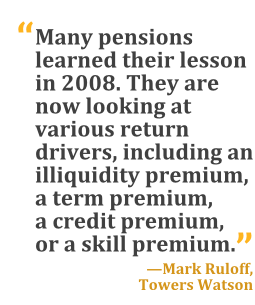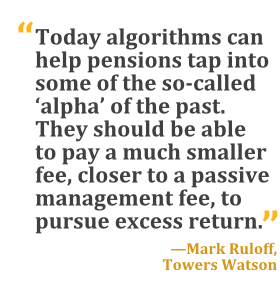 Global pension plans continue to grow. Fund assets reached new highs in 2014, with the United States leading the way.
Global pension plans continue to grow. Fund assets reached new highs in 2014, with the United States leading the way.
That's the headline news from the Towers Watson “Global Pension Assets Study 2015.” The firm examined changes in pension plans' asset portfolios in 16 markets around the world. At the end of 2014, the total value across all 16 markets was US$36 trillion. The total value of U.S. pensions' assets was $22.1 trillion, which comes to 127 percent of U.S. GDP. Only in the Netherlands is the cumulative value of pension assets higher relative to GDP.
The study found that the enormous size of some pension plans is affecting their asset allocation choices, according to Mark Ruloff, director of asset allocation with Towers Watson. “Some of these funds are so big that they could be referred to as a 'universal owner,'” Ruloff says. “They own a piece of virtually everything. When something bad happens in the world, or there's a catastrophe of some sort that has a negative impact on the earth or on the financial system in general, then that will have a negative impact on these investors.”
As a result, Ruloff reports, some pension asset managers are shifting from a “pure finance way of seeing pension investing”—an approach that focuses only on short-term performance—to an approach that emphasizes longer-term sustainable growth. “They do not want to make investments that could potentially be deteriorating the planet—for example, using water resources to excess,” he says. “They see that investing in a sustainable company is going to have a better impact on their portfolio over the long term.”
Another trend that the Towers Watson study highlighted is the shift of assets from defined benefit to defined contribution plans. Among the seven largest pension markets, defined contribution assets represent almost half of all assets. In the United States, they represent more than half—58 percent, while 42 percent of all U.S. pension assets reside in defined benefit plans.
 At the same time, pension funds in the world's largest markets are shifting their portfolios from equities toward cash and alternative investments. In the United States, holdings of cash increased from 0 percent in 2004 to 2 percent of all pension plan assets at the end of last year. Holdings in “other assets,” which comprises investments such as real estate, hedge funds, private equity, commodities, and even catastrophic bonds in the reinsurance area, nearly doubled from 16 percent to 29 percent over the same period. Meanwhile, U.S. pensions' equity holdings declined over the past decade from 60 percent of the total portfolio to just 44 percent.
At the same time, pension funds in the world's largest markets are shifting their portfolios from equities toward cash and alternative investments. In the United States, holdings of cash increased from 0 percent in 2004 to 2 percent of all pension plan assets at the end of last year. Holdings in “other assets,” which comprises investments such as real estate, hedge funds, private equity, commodities, and even catastrophic bonds in the reinsurance area, nearly doubled from 16 percent to 29 percent over the same period. Meanwhile, U.S. pensions' equity holdings declined over the past decade from 60 percent of the total portfolio to just 44 percent.
“Pension funds are investing in all sorts of things outside the norm of the typical equity/bond tradeoff,” Ruloff explains. “They're shifting from equities into these other types of investments to get more diversification.” And that's not their only change in risk management strategy. “It's not just a matter of the asset class itself,” Ruloff says. “They're moving away from the equity risk premium toward other return drivers. For example, think of private equity. It definitely has an equity risk premium, but in private equity there's also an illiquidity premium, so pensions are trying to get that illiquidity premium as well.”
These shifts reflect an improvement in pension risk management at U.S. entities, he adds. “Many pensions learned their lesson from the crisis in 2008. Before then, some may have thought they were diversified by being in large-cap stocks, small-cap stocks, international equities, and emerging markets. But those were all equities, and they went down together. So they are now thinking, 'How can I diversify away from the equity risk premium?' They're looking at various return drivers, including an illiquidity premium, a term premium, a credit premium, or a skill premium—for example, when you invest with a hedge fund manager who is hopefully going to bring you some skill.”
 One nuance in this trend, which the survey didn't parse out, is how different types of pension plans might be reacting differently to current economic factors. Ruloff says Towers Watson has noticed recently that corporate pensions and government plans are taking significantly different approaches to asset management, particularly in their bond investments. Overall, U.S. pensions' bonds as a proportion of all assets rose very slightly over the past decade, from 24 percent in 2004 to 25 percent at the end of last year. But that's not the whole story.
One nuance in this trend, which the survey didn't parse out, is how different types of pension plans might be reacting differently to current economic factors. Ruloff says Towers Watson has noticed recently that corporate pensions and government plans are taking significantly different approaches to asset management, particularly in their bond investments. Overall, U.S. pensions' bonds as a proportion of all assets rose very slightly over the past decade, from 24 percent in 2004 to 25 percent at the end of last year. But that's not the whole story.
“Corporate pension plans have been more focused on hedging their liabilities, and perhaps increasing their allocation to bonds, over the past 10 years,” Ruloff says. “But public pension plans are more focused on attempting to achieve their expected rate of return and therefore have been moving away from bonds because of the low-yield environment.”
What trends does Towers Watson expect to emerge on future iterations of this survey? One prediction is that a more effective “value chain” will soon guide pension asset management decisions. “Today algorithms can help pensions tap into some of the so-called 'alpha' of the past, the outperformance of the asset portfolio compared with equity markets,” Ruloff says. “So plans shouldn't be paying a lot for that. They should be able to pay a much smaller fee, closer to a passive management fee, for using an algorithm to pursue the excess return.”
For plan sponsors managing funds whose cumulative asset values exceed the annual domestic output of the U.S. economy, the prospect of lower fees is a bright spot on a horizon otherwise clouded with uncertainty.
© Touchpoint Markets, All Rights Reserved. Request academic re-use from www.copyright.com. All other uses, submit a request to [email protected]. For more inforrmation visit Asset & Logo Licensing.



